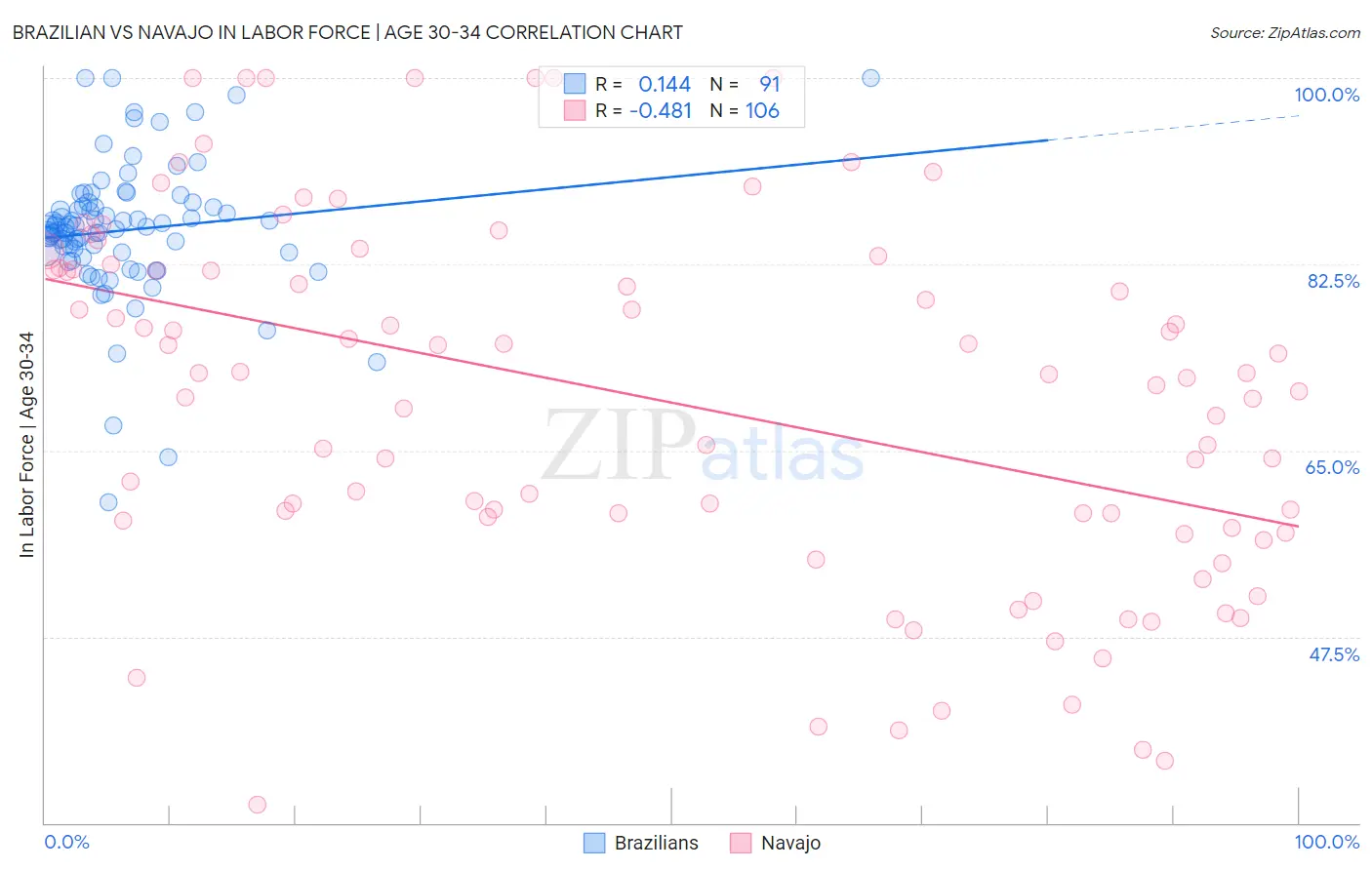Brazilian vs Navajo In Labor Force | Age 30-34
COMPARE
Brazilian
Navajo
In Labor Force | Age 30-34
In Labor Force | Age 30-34 Comparison
Brazilians
Navajo
85.4%
IN LABOR FORCE | AGE 30-34
99.1/ 100
METRIC RATING
70th/ 347
METRIC RANK
73.8%
IN LABOR FORCE | AGE 30-34
0.0/ 100
METRIC RATING
347th/ 347
METRIC RANK
Brazilian vs Navajo In Labor Force | Age 30-34 Correlation Chart
The statistical analysis conducted on geographies consisting of 323,771,960 people shows a poor positive correlation between the proportion of Brazilians and labor force participation rate among population between the ages 30 and 34 in the United States with a correlation coefficient (R) of 0.144 and weighted average of 85.4%. Similarly, the statistical analysis conducted on geographies consisting of 224,771,118 people shows a moderate negative correlation between the proportion of Navajo and labor force participation rate among population between the ages 30 and 34 in the United States with a correlation coefficient (R) of -0.481 and weighted average of 73.8%, a difference of 15.8%.

In Labor Force | Age 30-34 Correlation Summary
| Measurement | Brazilian | Navajo |
| Minimum | 60.2% | 31.7% |
| Maximum | 100.0% | 100.0% |
| Range | 39.8% | 68.3% |
| Mean | 85.7% | 69.8% |
| Median | 86.0% | 72.0% |
| Interquartile 25% (IQ1) | 83.6% | 58.5% |
| Interquartile 75% (IQ3) | 88.0% | 82.0% |
| Interquartile Range (IQR) | 4.4% | 23.6% |
| Standard Deviation (Sample) | 6.5% | 16.9% |
| Standard Deviation (Population) | 6.4% | 16.8% |
Similar Demographics by In Labor Force | Age 30-34
Demographics Similar to Brazilians by In Labor Force | Age 30-34
In terms of in labor force | age 30-34, the demographic groups most similar to Brazilians are Immigrants from Japan (85.4%, a difference of 0.0%), Immigrants from China (85.4%, a difference of 0.010%), Indian (Asian) (85.4%, a difference of 0.010%), Maltese (85.4%, a difference of 0.010%), and Immigrants from Iran (85.4%, a difference of 0.020%).
| Demographics | Rating | Rank | In Labor Force | Age 30-34 |
| Macedonians | 99.4 /100 | #63 | Exceptional 85.5% |
| Italians | 99.4 /100 | #64 | Exceptional 85.4% |
| Senegalese | 99.4 /100 | #65 | Exceptional 85.4% |
| Ghanaians | 99.4 /100 | #66 | Exceptional 85.4% |
| Kenyans | 99.3 /100 | #67 | Exceptional 85.4% |
| Immigrants | Eastern Europe | 99.3 /100 | #68 | Exceptional 85.4% |
| Immigrants | Iran | 99.2 /100 | #69 | Exceptional 85.4% |
| Brazilians | 99.1 /100 | #70 | Exceptional 85.4% |
| Immigrants | Japan | 99.1 /100 | #71 | Exceptional 85.4% |
| Immigrants | China | 99.0 /100 | #72 | Exceptional 85.4% |
| Indians (Asian) | 99.0 /100 | #73 | Exceptional 85.4% |
| Maltese | 99.0 /100 | #74 | Exceptional 85.4% |
| Immigrants | Czechoslovakia | 99.0 /100 | #75 | Exceptional 85.4% |
| Iranians | 99.0 /100 | #76 | Exceptional 85.4% |
| Immigrants | Eastern Asia | 98.9 /100 | #77 | Exceptional 85.4% |
Demographics Similar to Navajo by In Labor Force | Age 30-34
In terms of in labor force | age 30-34, the demographic groups most similar to Navajo are Crow (75.9%, a difference of 2.9%), Yup'ik (76.4%, a difference of 3.6%), Yuman (77.1%, a difference of 4.5%), Lumbee (77.3%, a difference of 4.8%), and Tohono O'odham (77.7%, a difference of 5.4%).
| Demographics | Rating | Rank | In Labor Force | Age 30-34 |
| Inupiat | 0.0 /100 | #333 | Tragic 79.7% |
| Hopi | 0.0 /100 | #334 | Tragic 79.3% |
| Marshallese | 0.0 /100 | #335 | Tragic 79.2% |
| Natives/Alaskans | 0.0 /100 | #336 | Tragic 79.2% |
| Yakama | 0.0 /100 | #337 | Tragic 79.1% |
| Pima | 0.0 /100 | #338 | Tragic 79.0% |
| Apache | 0.0 /100 | #339 | Tragic 79.0% |
| Ute | 0.0 /100 | #340 | Tragic 78.9% |
| Immigrants | Yemen | 0.0 /100 | #341 | Tragic 78.2% |
| Tohono O'odham | 0.0 /100 | #342 | Tragic 77.7% |
| Lumbee | 0.0 /100 | #343 | Tragic 77.3% |
| Yuman | 0.0 /100 | #344 | Tragic 77.1% |
| Yup'ik | 0.0 /100 | #345 | Tragic 76.4% |
| Crow | 0.0 /100 | #346 | Tragic 75.9% |
| Navajo | 0.0 /100 | #347 | Tragic 73.8% |